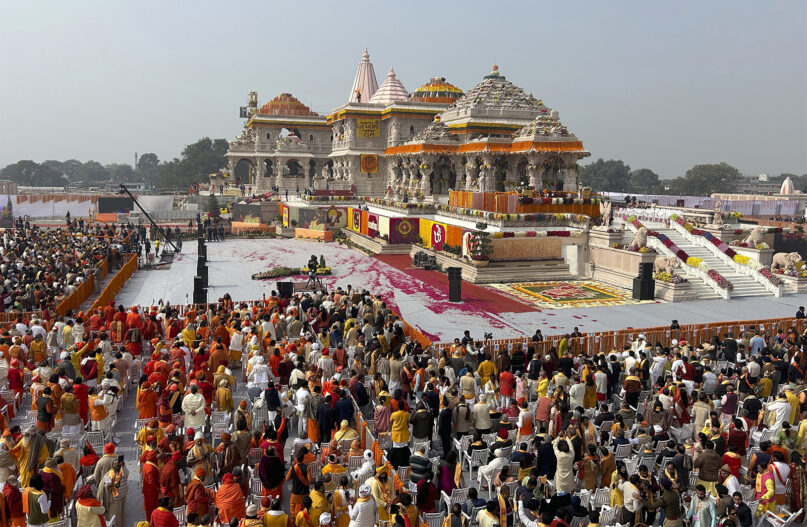(RNS) — This week, Hindus around the world and Indians of all faiths are marking the opening of the Ram Mandir, a temple planned and built over decades in Ayodhya, the northern Indian city believed to be the birthplace of Lord Ram, the Hindu deity whose renown extends beyond the Hindu faith.
The opening of the temple has been an emotional event for many in India and in the diaspora. While galvanizing Hindu pride, the mandir is built over the remains of Babri Masjid, a 16th-century mosque commissioned by the Mughal Emperor Babur, which in turn was likely built over the remains of a more ancient temple dedicated to Lord Ram. While it was common for Muslim rulers and Portuguese Catholic colonizers to destroy Hindu temples and build their own houses of worship over them, the Ayodhya site was more contentious, occupying ground with deep scriptural significance to Hindus as well as Buddhists, Jains and Sikhs.
The debate over who had the right to build on the spot turned into litigation. As it dragged on, an impatient mob of right-wing Hindus destroyed the mosque in 1992, triggering riots and years of recriminations. Some Hindu organizers of the protests expressed regret about the mosque’s destruction, arguing that it ran counter to the principles of Ram as he is depicted in epics such as the Ramayana and Ramcharitmanas, and of dharma itself.
But like so many histories, the story of the disputed site is complex and unwritten. As my University of Pennsylvania colleague Jonathan Zimmerman has noted, in addressing the Israel/Hamas war, histories cannot be oversimplified and sanitized, nor can they be relegated to a single story. There is space to acknowledge the hurt Hindus felt about the burial of their heritage at the site while recognizing the trauma Indian Muslims experienced in the masjid’s destruction.
In the Indian subcontinent more broadly, the dynamics of oppressor and oppressed are not easily defined. Muslim and Christian empires both ruled South Asia for centuries, with all the destructiveness of colonizers. Hindus for generations were subjects in their own homeland. The rise of a right-wing Hindu political ethos in the past decades has overshadowed a more widespread desire among Hindus to reassert their cultural and religious prominence in a country where nearly 80% of the population follows the religion.
As the inauguration continues this week and members of every faith join in the celebration, there’s a unique opportunity for India to re-imagine its pluralism in a way that respects Hinduism and the multitude of religions practiced across the country. The Indian Supreme Court’s decision to allow the Ram Mandir to be built provided five acres of land for the construction of a mosque in Ayodhya. But it’s just a start.
To achieve this end, Indian Prime Minister Narendra Modi and members of his right-wing party would be wise to use the Ram Mandir as a means of encouraging dialogue in a country where religious polarization is hardening. The Modi government has an opportunity to accomplish what other South Asian nations have not been able to: righting historical wrongs in a way that brings different faith groups together on a large scale.
In neighboring Pakistan, former Prime Minister Imran Khan vowed to rebuild and preserve Hindu temples that have been destroyed or fallen into disrepair since the country’s 1947 partition from India. He was forced to renege on that promise under pressure from right-wing Muslims. Modi would face similar pressure, but having brought Indians together with the Ayodhya temple’s opening, he could add to his legacy if he used his political capital to improve Hindu-Muslim relations.
The Ram Mandir’s significance to Hindus worldwide cannot be underestimated, but its importance as a bridge builder between civilizational India and the modern Indian nation-state looms just as large. Here’s to hoping that the jubilation of this week can be a small step toward healing the wounds of the past few decades.
(Murali Balaji is a journalist and a lecturer at the Annenberg School for Communication at the University of Pennsylvania. His books include “Digital Hinduism” and “The Professor and the Pupil,” a political biography of W.E.B. Du Bois and Paul Robeson. The views expressed in this commentary do not necessarily reflect those of Religion News Service.)





